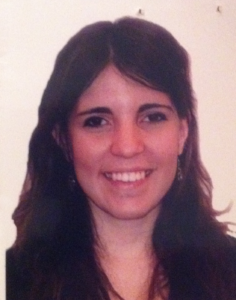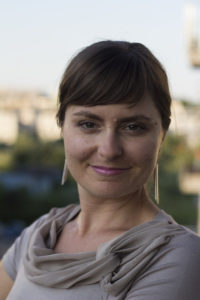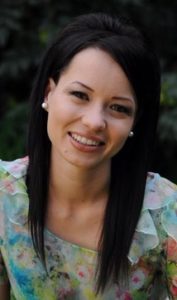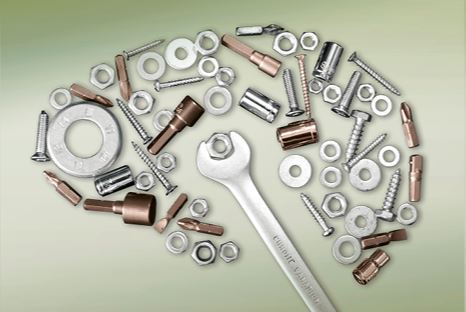
Report from Dr Giulia Coarelli from Roma, Italy visiting the ICM (Institut du Cerveau et de la Moelle épinière) INSERM U1127, CNRS UMR7225, UPMC UMR_S1127, 47 Boulevard de l’Hôpital, 75013 Paris, France under the supervision of Professor Alexandra Durr
(Term: 2.11.2015-30.4.2016)
This clinical fellowship allowed me to join an excellent research center (ICM) with a great supervisor, Prof. Alexandra DURR. I have taken advantage of the precious expertise of Prof. DURR to examine patients with hereditary neurological diseases such as the Huntington disease, cerebellar ataxias and spastic paraplegias. I had the chance to work in France‘s most advanced center for these diseases and which counts a large number of patients: a very important aspect considering the rarity of these diseases. On a daily bases I conducted outpatient clinical exams, first medical exams and/or follow up visits. All this has allowed me to broaden my knowledge in neurology and to became familiar with these rare diseases first hand. I was also able to explore the radiological procedures by reading brain and spinal cord MRI, together with other radiological exams. Another important aspect that I was able to analize thanks to the fellowship is the genetics about the causes underlying rare diseases. In the last years a large number of genes are constantly discovered and new classifications of genetic movement disorders are proposed.
The possibility to test patients by next generation sequencing panels available for dominant, recessive, congenital ataxias and for hereditary spastic paraplegias, and in same cases the opportunity to analyse by whole exome sequencing, enhances the probability to find the genetic mutations which cause the disorders. Moreover, the expertise of this clinical and reserach centre is remarkable during the monthly genetic meeting, when the most difficult cases are presented and different genetic causes are evaluated. Furthermore, the genetic results are discussed by the multidisciplinary team composed by geneticists, neurologists and biologists to understand whether the results of genetic mutations could be represent the real cause of the disorder or if the mutation is only a variant which is met also in control subjects. Moreover, the activity of counseling in multistep and multidisciplinary teams is important for presymptomatic testing in persons at risk of these disorders and the Department led by Prof. Durr has a valid experience in this field. The patients are followed also in pregnancy projects and preimplantation genetic diagnosis are available in collaboration with psychologists and gynaecologists. So, I had the opportunity to analyse these diseases from all points of view, both from genetic and biological basis and to psycological effect on the person, his family and the choise relating to the progeny. Prof. Durr is involved not only in clinical activities but also in clinical researches, recognized all over the world. She is a coordinator of SPATAX network and together with the other members, has assembled the largest collection of families and achieved a number of tasks like initiation of a clinical and genetic database, distribution of DNA to participating laboratories, mapping of new loci and refinement of several loci.
During this fellowship semester I got to know this network and its activities. The association of the rare disease reference centers allows to include easier patients with these rare sub-forms of neurological diseases in clinical trials. Their longstanding research in natural history features allow us to investigate the individual trajectory of each patient included, and the treatment effect on the expected progression. I have known and participated at the ongoing clinical trials directed by Prof. Durr in Friedreich Ataxia, Huntington disease and Spinocerebellar Ataxias and I could go through the results of past studies. I learned how to use several clinical scales in order to examine patients such as SARA (Scale for the Assessment and Rating of the Ataxia), INAS (Inventoy of Non-Ataxia Signs), SPRS (Spastic Paraplegia Rating Scale), and UHDRS (Unified Huntington‘s Disease Rating Scale). During this period I focus on dominant ataxias and I followed the clinical evaluations of more than 400 patients studied by an amplicon-based panel sequencing technique for 65 genes. I examined the transmission manner of inheritance (only dominant transmission was taking into account), demographic characteristics, neurological status considering cerebellar, extrapyramidal, pyramidal, oculomotor, dysautonomic signs.
Once again, I have to recognize that I have been lucky to get to work with Prof. Durr, a brilliant clinician and researcher who taught me, with a high dose of passion, how to approach these diseases, from biological basis to neurological details and psychological status and how to make a genetic diagnosis from the clinical phenotypes and how to support patients and their families, also in the cases where a genetic mutation has not been proved.

Report from Dr Ewa Czapinska-Ciepiela from Krakow, Poland visiting the Paracelsus Medical University, Christian Doppler Klinik, Department of Neurology, Salzburg, Austria, under the supervision of Professor Eugen Trinka
(Term: 2.5.-15.6.2016)
I was staying in the Department of Neurology in Christian Doppler Klinik in Salzburg, Austria from 2nd of May until 15th of June 2016. My main focus during the Clinical Fellowship was the diagnosis and management of the patients suffering from epilepsy.
In order to develop my knowledge in this field I participated actively in everyday activities of the Epilepsy Monitoring Unit. With the fellow neurologists I admitted patients to hospital every week for the evaluation of their epilepsy. During the hospitalization we were observing their seizures’ semiology and the EEG pattern. Then taking into consideration the results of video-monitoring and other findings in MRI, PET and SPECT we were making decisions regarding their treatment.
Moreover every week I attended the Seizure Conference which was organized by Professor Trinka and the neurologists from the Epilepsy Monitoring Unit in order to evaluate the possibilities for the neurosurgical operations of the patients observed previously in the Epilepsy Monitoring Unit. During the conferences we discussed the probability of a successful operation with the neurosurgeon and the issues concerning the cognitive functions with the neuropsychologist.
During my stay I have also obtained the basic knowledge of the EEG. With the fellow colleagues I analyzed the EEG patterns of the patients currently staying in the hospital and the patients from the outpatient clinic. We also performed the treatment of status epilepticus with intravenous antiepileptic medication according to the Salzburg consensus statement for treatment of status epilepticus whenever such a clinical condition of a patient was confirmed in the EEG.
In order to gain more experience in the treatment of epilepsy I often participated in patients’ visits to the outpatient clinic. I have obtained the knowledge of the different schemes of the treatment for certain types of epileptic seizures. I have also had an opportunity to learn the management of epilepsy in particular groups of patients such as the elderly, the pregnant women, the disabled and the patients with special epilepsy syndromes.
In overall I find my Clinical Fellowship in Christian Doppler Klinik very educational. During my stay I have obtained the experience and the knowledge that is crucial for my work and my career as an epileptologist. This will enable me to further develop this medical field in Poland for the benefit of my patients and my fellow neurologists.
Report from Dr Abdelhady Salem Taha Alsayed from Cairo, Egypt visiting the Inselspital, Bern University Hospital, Bern, Switzerland, under the supervision of Dr. Kai Rösler
(Term: 2.5.-7.6.2016)
My fellowship started on May the second. I had the opportunity to observe a lot of basic neurography of the median nerve, ulnar nerve, tibial and peroneal nerves, some rare neurography as the radial nerve neurography, medial planter neurography for tarsal tunnel syndrome, lateral cutaneous nerve of the forearm, anterior interosseous nerve of the median nerve, assessment of brachial plexus affection and injury.
Basic EMG of the muscles
I also observed (for the first time for me) all kinds of evoked potentials ranging from visual evoked potential, somatosensory evoked potentials for the lower limps and for the upper limps, trible stimulation for screening of ALS.
Also, I observed the assessment of the autonomic nerves system by sudumotor test (Thermoregulatory sweat test) and heart rate variability analysis.
 Report from Dr Andrea Réka Balogh from Targu Mures, Romania, visiting the AMEOS Klinikum Bernburg GmbH – Department of Neurology, Bernburg, Germany under the supervision of Dr. Steffen Eue
Report from Dr Andrea Réka Balogh from Targu Mures, Romania, visiting the AMEOS Klinikum Bernburg GmbH – Department of Neurology, Bernburg, Germany under the supervision of Dr. Steffen Eue
(Term: 29.2.-8.4.2016)
I spent my clinical fellowship in Bernburg, Germany, in the period between 01.02.2016- 09.04.2016.
First of all I would like to thank to the EAN for this special oportunity for me, to achieve knowledge and experience in neurology and trombolisys. I spent these six weeks in the stroke unit of Ameos Klinikum Bernburg, neurology department.
During the fellowship I observed and took part of the daily work in the hospital with Dr. Michael Grumbt and Dr. Anika Latsch, specialists of the stroke unit. The stroke unit had aproximatively 40 beds, and it had three parts, the first one for the patients with acute stroke and hemoragic cerebral accidents, the second one for patients with 48 hours after the acute phase, and the third one for patients waiting for the transfer in the right rehabilitation hospital. The program in the hospital started at 7:30 in the morning with a presentation of the patients who were hospitalized in the permanent medical servic unit, after that I participated to the daily visit with the stroke units head of department. During the days I also observed and then helped the resident doctors on call, with the examination and hospitalization of the new patients. At 13:15 it was the daily meeting with the chief of department Dr. Eue Steffen, and at 13:45 the neuroradiologist presented the daily imagistic examinationts ( CT,MRI, Rontgen scans) of the patients. At 14:30 I participated at the second visit of the stroke unit, (on wednesdays and fridays chief visit, on the other das of the week with Dr. Grumbt or Dr. Latsch). After this, I helped the clinics resident doctors with lumbal punctions and with the administrative work in the hospital. I also helped in the administrative tasks related to the hospitalization, treatment and externation of the patients.
During these six weeks I saw many trombolisys finalized with therapeutic succes, I had the oportunity to ask and observe how the stroke unit works, the managment, the organizations of the inside hospital routes of these patiens, to learn how to applie the including and excluding trombolisys criterias, to learn the post trombolisys therapy and patients cares steps, wich all I could implement in my hospital.
During the clinical fellowship the hospital offered me a house to live, so I didn’t had to spent money for that. The biggest part of my expenses were generated by the daily amounts for food, public transportation and the travel to and from Bernburg to Targu-Mures.







